This article needs additional citations for verification .(October 2008) |
Reed mats are handmade mats of plaited reed or other plant material.
This article needs additional citations for verification .(October 2008) |
Reed mats are handmade mats of plaited reed or other plant material.

In Japan, a traditional reed mat is the tatami (畳). Tatami are covered with a weft-faced weave of soft rush (藺草, igusa) (common rush), on a warp of hemp or weaker cotton. There are four warps per weft shed, two at each end (or sometimes two per shed, one at each end, to cut costs). The doko (core) is traditionally made from sewn-together rice straw, but contemporary tatami sometimes have compressed wood chip boards or extruded polystyrene foam in their cores, instead or as well. The long sides are usually edged (縁, heri) with brocade or plain cloth, although some tatami have no edging. [1] [2]
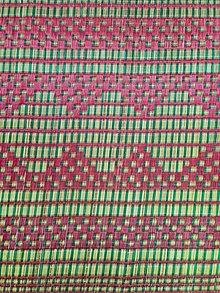
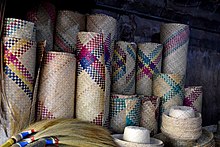
In the Philippines, woven reed mats are called banig. They are used as sleeping mats or floor mats, and were also historically used as sails. They come in many different weaving styles and typically have colorful geometric patterns unique to the ethnic group that created them. They are made from buri palm leaves, pandan leaves, rattan, or various kinds of native reeds known by local names like tikog, sesed ( Fimbristykis miliacea ), rono, or bamban. [3] [4]
In Thailand and Cambodia, the mats are produced by plaiting reeds, strips of palm leaf, or some other easily available local plant. The supple mats made by this process of weaving without a loom are widely used in Thai homes. These mats are also now being made into shopping bags, place mats, and decorative wall hangings.
One popular kind of Thai mat is made from a kind of reed known as Kachud, which grows in the southern marshes. After the reeds are harvested, they are steeped in mud, which toughens them and prevents them from becoming brittle. They are then dried in the sun for a time and pounded flat, after which they are ready to be dyed and woven into mats of various sizes and patterns.
Other mats are produced in different parts of Thailand, most notably in the eastern province of Chanthaburi. Durable as well as attractive, they are plaited entirely by hand with an intricacy that makes the best resemble finely woven fabrics.

In India, reed mats (called paay in Tamil or chatai in Hindi) are used as cooling and eco-friendly floor coverings. [5]

Bead weaving is a set of techniques for weaving sheets and objects of seed beads. Threads are strung through and/or around the beads to hold them together. It can be done either on a loom or using one of a number of off-loom stitches.

A loom is a device used to weave cloth and tapestry. The basic purpose of any loom is to hold the warp threads under tension to facilitate the interweaving of the weft threads. The precise shape of the loom and its mechanics may vary, but the basic function is the same.

Weaving is a method of textile production in which two distinct sets of yarns or threads are interlaced at right angles to form a fabric or cloth. Other methods are knitting, crocheting, felting, and braiding or plaiting. The longitudinal threads are called the warp and the lateral threads are the weft, woof, or filling. The method in which these threads are interwoven affects the characteristics of the cloth. Cloth is usually woven on a loom, a device that holds the warp threads in place while filling threads are woven through them. A fabric band that meets this definition of cloth can also be made using other methods, including tablet weaving, back strap loom, or other techniques that can be done without looms.

A tatami (畳) is a type of mat used as a flooring material in traditional Japanese-style rooms. Tatamis are made in standard sizes, twice as long as wide, about 0.9 m by 1.8 m depending on the region. In martial arts, tatami are the floor used for training in a dojo and for competition.

Juncaceae is a family of flowering plants, commonly known as the rush family. It consists of 8 genera and about 464 known species of slow-growing, rhizomatous, herbaceous monocotyledonous plants that may superficially resemble grasses and sedges. They often grow on infertile soils in a wide range of moisture conditions. The best-known and largest genus is Juncus. Most of the Juncus species grow exclusively in wetland habitats. A few rushes, such as Juncus bufonius are annuals, but most are perennials.

Zori, also rendered as zōri, are thonged Japanese sandals made of rice straw, cloth, lacquered wood, leather, rubber, or—most commonly and informally—synthetic materials. They are a slip-on descendant of the tied-on waraji sandal.
Ikat is a dyeing technique originating from Indonesia used to pattern textiles that employs resist dyeing on the yarns prior to dyeing and weaving the fabric.

Tablet weaving is a weaving technique where tablets or cards are used to create the shed through which the weft is passed. As the materials and tools are relatively cheap and easy to obtain, tablet weaving is popular with hobbyist weavers. Currently most tablet weavers produce narrow work such as belts, straps, or garment trims.

Kasuri (絣) is the Japanese term for fabric that has been woven with fibers dyed specifically to create patterns and images in the fabric, typically referring to fabrics produced within Japan using this technique. It is a form of ikat dyeing, traditionally resulting in patterns characterized by their blurred or brushed appearance.

Silk In India, about 97% of the raw mulberry silk is produced in the Indian states of Karnataka, Andhra Pradesh, Tamil Nadu and West Bengal. Mysore and North Bangalore, the upcoming site of a US$20 million "Silk City", contribute to a majority of silk production. Another emerging silk producer is Tamil Nadu where mulberry cultivation is concentrated in Salem, Erode and Dharmapuri districts. Hyderabad, Andhra Pradesh and Gobichettipalayam, Tamil Nadu were the first locations to have automated silk reeling units.
The manufacture of textiles is one of the oldest of human technologies. To make textiles, the first requirement is a source of fiber from which a yarn can be made, primarily by spinning. The yarn is processed by knitting or weaving, which turns yarn into cloth. The machine used for weaving is the loom. For decoration, the process of colouring yarn or the finished material is dyeing. For more information of the various steps, see textile manufacturing.

In weaving, the shed is the temporary separation between upper and lower warp yarns through which the weft is woven. The shed is created to make it easy to interlace the weft into the warp and thus create woven fabric. Most types of looms have some sort of device which separates some of the warp threads from the others. This separation is called the shed, and allows for a shuttle carrying the weft thread to move through the shed perpendicular to the warp threads. Which threads are raised and which are lowered are changed after each pass of the shuttle.
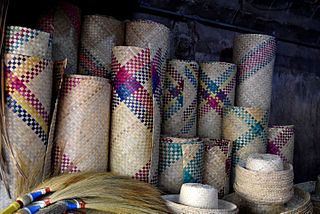
A baníg is a traditional handwoven mat of the Philippines predominantly used as a sleeping mat or a floor mat. Depending on the region of the Philippines, the mat is made of buri (palm), pandanus or reed leaves. The leaves are dried, usually dyed, then cut into strips and woven into mats, which may be plain or intricate.
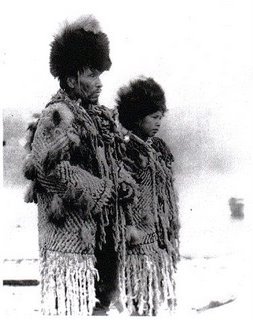
Salish are skilled weavers and knitters of the Pacific Northwest. They are most noted for their beautiful twill blankets many of which are very old. The adoption of new fabrics, dyes, and weaving techniques allow us to study a wide variety of Salish weavings today.

A reed is part of a weaving loom, and resembles a comb or a frame with many vertical slits. It is used to separate and space the warp threads, to guide the shuttle's motion across the loom, and to push the weft threads into place. In most floor looms with, the reed is securely held by the beater. Floor looms and mechanized looms both use a beater with a reed, whereas Inkle weaving and tablet weaving do not use reeds.
A woven mat is a type of mat that is created by weaving and may include:
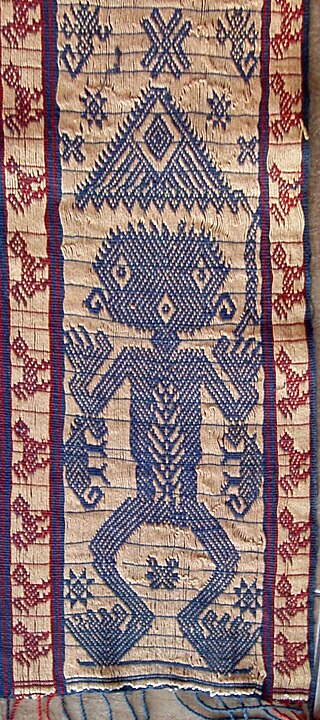
Supplementary weaving is a decorative technique in which additional threads are woven into a textile to create an ornamental pattern in addition to the ground pattern. The supplementary weave can be of the warp or of the weft. Supplementary weave is commonly used in many of thetextiles of Southeast Asia such as in Balinese textiles, the textiles of Sumba and the songket of Sumatra, Malaysia and Brunei.

Madurkathi mats, or madur, are mats woven in West Bengal from a reed called madur kottir, or madurkathi, a sedge of the family Cyperaceae. Madur mat-making is a long-standing tradition, centred on the Medinipur district, and is an important part of the rural economy. The mats are woven mainly by weavers of the Mahishya caste, and predominantly by women. This cottage industry contributes significantly to village household income.
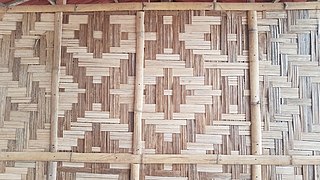
Amakan, also known as sawali in the northern Philippines, is a type of traditional woven split-bamboo mats used as walls, paneling, or wall cladding in the Philippines. They are woven into various intricate traditional patterns, often resulting in repeating diagonal, zigzag, or diamond-like shapes. The term "sawali" is more properly defined as twilled weaving patterns. The term can also be applied to baskets and banig, which also use the same weaving patterns. Amakan panels are commonly confused with nipa walls, which are made from thatched leaves.
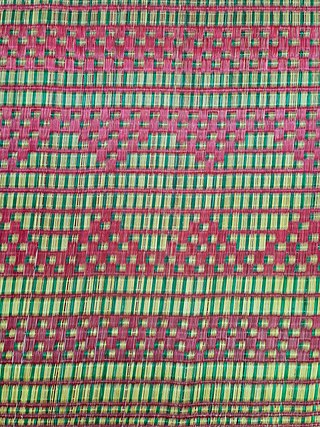
A Cambodian mat also known as a kantael is a woven mat made from palm or reed in Cambodia. The Cambodian mat consists of an ordinary mat, below which are fixed pads of strongly packed cotton, with the help of a special loom. They are specific to the Khmer people.